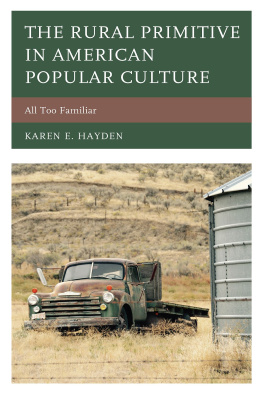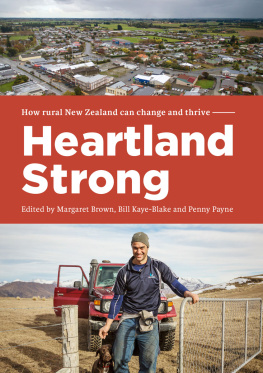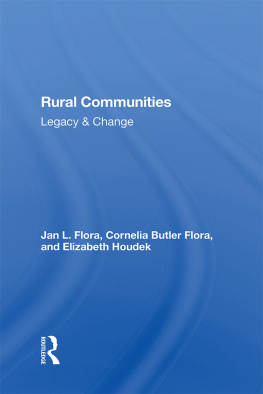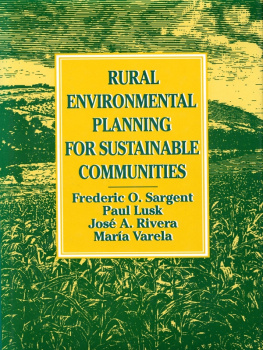First published 1990 by Westview Press, Inc.
Published 2018 by Routledge
52 Vanderbilt Avenue, New York, NY 10017
2 Park Square, Milton Park, Abingdon, Oxon OX14 4RN
Routledge is an imprint of the Taylor & Francis Group, an informa business
Copyright 1990 Taylor & Francis
All rights reserved. No part of this book may be reprinted or reproduced or utilised in any form or by any electronic, mechanical, or other means, now known or hereafter invented, including photocopying and recording, or in any information storage or retrieval system, without permission in writing from the publishers.
Notice:
Product or corporate names may be trademarks or registered trademarks, and are used only for identification and explanation without intent to infringe.
Library of Congress Cataloging-in-Publication Data
American rural communities.
(Westview special studies in contemporary social issues)
1. United StatesRural conditions. 2. Rural developmentUnited States. 3. United StatesEconomic conditions1981- . I. Luloff, A.E. II. Swanson. Louis E. III. Series.
HN59.2.A45 1990 307.7'2'0973 88-26195
ISBN 13: 978-0-367-01267-0 (hbk)
This book is dedicated to the people of rural America whose struggle to make community meaningful provides important lessons for all of us.
We also dedicate this effort to those who struggled with us: Marcia, Samara, Lauren, David, Carol, and Eric.
The citizens who provide at once their own food and raiment, may be viewed as the most truly independent. It follows, that the greater the proportion of this class to the whole society, the more free, the more independent, and the more happy must be the society itself.
James Madison, 1792
It has become routine to hear that some vital segment of society, some venerable institution, or some other basic element of American life has reached a critical point. I do not, however, hesitate to say that we are at a monumental watershed for rural America, which may possibly determine the very survival of that national institution that is in any way recognizable as the rural America of my boyhood in the 1930s.
We all know that rural America is where most of our food, a good chunk of our positive balance-of-payments, much of our music, idiom, and dress, and many of our national values come from, but it is also much more. Rural America is not just a place and a people. It is a state of mind, a set of attitudes and perspectives, the backdrop for much of our folklore, and a museum of another America. It is also a refuge for thought and dream as evidenced by all the World War II veterans and their fantasies of a small, self-sufficient chicken farm, as well as many other things.
A number of historians have expressed the opinion that one portion of what was once rural Americathe Western Frontierstill pervades our thinking as a people and our actions as a nation. I submit that rural America as a whole has, does, and will continue to affect our outlook, our values, and our sense of nationhood. Rural America is not only worth saving, it absolutely must be saved for the good of the entire nation.
Preserving what remains of a depressed and contracting rural America requires intense attention and an immediate and serious commitment of resources to rural job and economic development. This process has been started, largely by the private sector, but it must be dramatically expanded in order to achieve success. This vital escalation demands the involvement of federal, state, and local governments.
Rural America is highly capable. But it requires some dedication of resources and expertise to set it on the path of a new self-sufficiency that has been unanticipated by even such men as James Madison and Ralph Waldo Emerson. The new rural America can be the equivalent of what Madison saw and extolled in the yeoman family farmer of two centuries ago. It can maintain its own viability and its own course after getting some initial help from the rest of the country, which is currently more on its economic feet. The less densely populated areas can once again be the haven for the fantasies of the urban worker, the place of peaceful respite for the retired, as well as the provider of America's sustenance. It may also become the refuge for the teeming urban millions on an unprecedented scale.
After World War II, a return to rural America was sought in the newly developed suburbs by tens of millions of urban dwellers. But, only too soon, the suburbs became parts of their respective cities and were included in "Standard Statistical Metropolitan Areas." These cities (especially the megacities), which rural people once vilified as crowded fleshpots like Sodom and Gomorrah, have begun to fulfill that prophecy as violence, drugs, overcrowding, pollution, and decay have made urban life less and less attractive. The congestion, violence, and terror, which are mostly urban phenomena, are frightening to everyone. Moving to a less-populated rural place seems to offer a sanctuary from these problems.
In fact, rural America serves a very important psychological function just by being the place to which one can dream about going. This is important for one's mental health, even if one knows on a pragmatic level that going there is only wishful thinking. The very existence of rural America has a vital function for America's psychic well-being. Since this nation became primarily an urban one (sometime in the 1940s or 1950s) rural America has physically deteriorated to a frightening extent: Rural housing, transportation, and medical care are in a desperate state in many parts of the nation.
The largest rural export today is talenthigh school graduates that do not stay in rural areas. The armed services have become the employers of last resort, and the kids who enlist can possibly get vocational training. The armed services provide a massive public education facility, which we are supporting with tax dollars, and it is the most expensive form of education.
The people of rural America are trying to pull themselves out of this economic and social quagmire by their boot straps but the private sector's boundaries are limited at the profit end. Private investment will not become involved in any enterprise that cannot show a profit; that is what drives the system. And, for much of what we do, this system works. But there are some very strict limits: The marketplace can establish price but not value, and government programs have got to pick up where the private sector leaves off.
To make rural revitalization work, there has got to be a government role. For example, we are seeing the rural areas lose populationthen the schools close and the hospitals close. And then comes the pressure to cut taxes. It frequently becomes a death spiral. Rural places with lower-income communities cannot afford to tax themselves and train kids to go off to a big-city job. They absolutely must create jobs in rural places. The private sector, by itself, cannot do it because necessary services like providing clean and adequate water, appropriately treating waste material, providing decent schools, good hospitals, and public transportation are all required.








